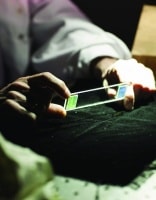The London-based company has announced the availability of TL1, a holographic optical component that will give augmented reality device developers a way of providing genuinely high-definition, full colour and transparent images over a user’s field of vision.
Developed in partnership with the National Physical Laboratory, TL1 consists of a glass waveguide, approximately 10cm long, 3cm wide and 2.8mm in thickness, with holograms attached at either end.
A display screen can act as the input device for the optic, with light from the screen travelling through a small collimating lens before striking the first hologram, which bends the light 90 degrees through the waveguide until it hits the second hologram, which then bends the light a further 90 degrees to be projected before the eye.
The TruLife Optics team anticipate a range of consumer and B2B applications, including fire fighting, surgery and maintenance, where instruction manuals are provided to people when they’re working at height on a pylon or working with complex machinery.
Simon Hall, lead scientist, Adaptive Optics at NPL said TL1 is not limited by the amount of light that can be put through it, with increased light throughput making the augmented image opaque and decreased throughput rendering an image transparent.
‘I think our technology is a lot better than a lot of the other wearable devices out there because…the optical component we’ve produced has a much smaller form factor and could be produced a lot more cheaply and also produces a better image that can be overlaid over your field of view,’ he said. ‘[In] a lot of the other wearable devices the image that you see of the computer screen isn’t actually overlaid over your field of view so the way we’ve produced our device is much more useable by a consumer or specialist user.’
‘We’re also getting very high fidelity of the actual image, and the actual component itself is not getting between the user and the real world and that’s a really key part,’ added Jonathan Lewis, chief executive of TruLife Optics. ‘You can’t augment something if you actually put a barrier between the user and the real world.’

Hall said other augmented technologies exist that use half-silvered mirrors or embedded optical components in thick lenses, and attempts to develop holographic solutions have not managed to generate a single volume hologram at each end of the waveguide.
‘Google’s solution is effectively a prism; it’s like a half-silvered mirror that you’re looking into,’ he said. ‘[With the] Epson Moverio you’re using an embedded, slightly different refractive index component in the very thick lens and that’s reflecting light travelling through the rather thick waveguide.’
TL1, which can be adapted to provide 3D images, is available for £300 per unit for developers creating prototype devices, and first orders are to be shipped in the next 10 days. Overall, the annual market revenues for AR devices are expected to grow to $5.2bn by 2016.
‘We’re willing and able to work with people to come up with more bespoke solutions,’ said Lewis. ‘What we’re really trying to do is put a marker in the sand which says we are really ready for any developer to now interact with us and to discuss what their requirements are.’
Looking forward, NPL will continue to work with TruLife Optics, a spin out from Colour Holographic, to further develop the technology and to provide additional sales and marketing support. Technology improvements will include improving colour correction, brightness and field of view, plus improvements to colour gradation issues; and miniaturising components.





Red Bull makes hydrogen fuel cell play with AVL
Surely EVs are the best solution for motor sports and for weight / performance dispense with the battery altogether by introducing paired conductors...